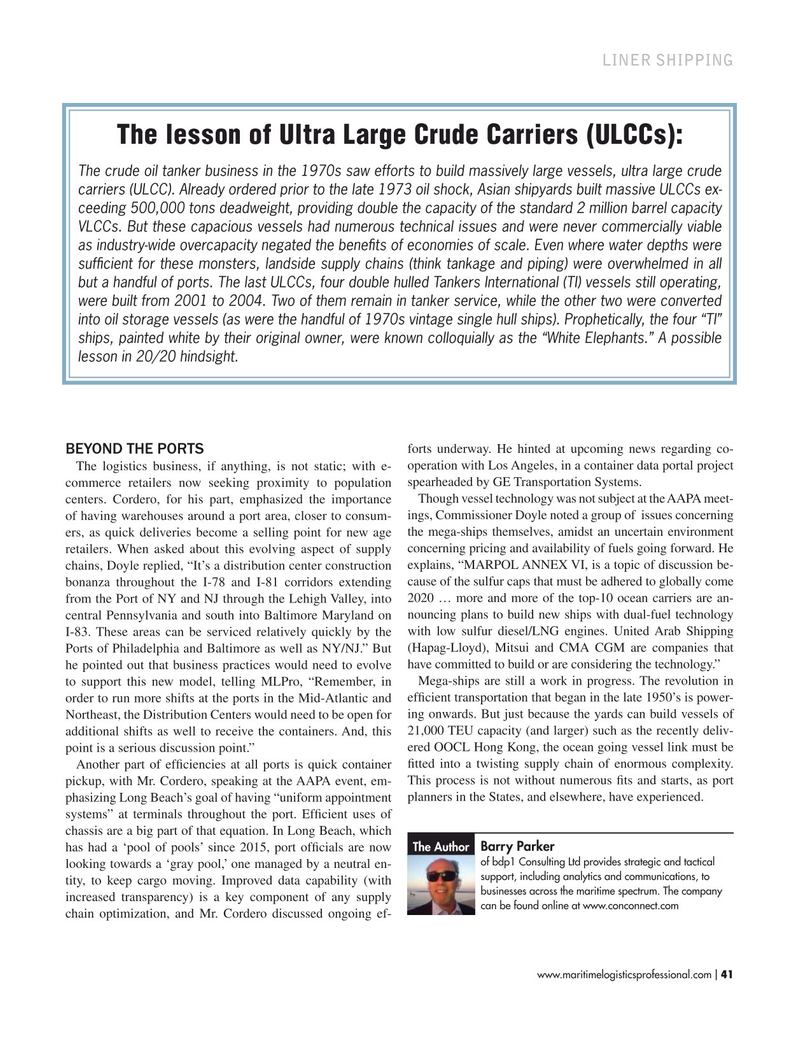
Page 41: of Maritime Logistics Professional Magazine (Sep/Oct 2017)
CONTAINER PORTS
Read this page in Pdf, Flash or Html5 edition of Sep/Oct 2017 Maritime Logistics Professional Magazine
LINER SHIPPING
The lesson of Ultra Large Crude Carriers (ULCCs):
The crude oil tanker business in the 1970s saw efforts to build massively large vessels, ultra large crude carriers (ULCC). Already ordered prior to the late 1973 oil shock, Asian shipyards built massive ULCCs ex- ceeding 500,000 tons deadweight, providing double the capacity of the standard 2 million barrel capacity
VLCCs. But these capacious vessels had numerous technical issues and were never commercially viable as industry-wide overcapacity negated the benefts of economies of scale. Even where water depths were suffcient for these monsters, landside supply chains (think tankage and piping) were overwhelmed in all but a handful of ports. The last ULCCs, four double hulled Tankers International (TI) vessels still operating, were built from 2001 to 2004. Two of them remain in tanker service, while the other two were converted into oil storage vessels (as were the handful of 1970s vintage single hull ships). Prophetically, the four “TI” ships, painted white by their original owner, were known colloquially as the “White Elephants.” A possible lesson in 20/20 hindsight.
forts underway. He hinted at upcoming news regarding co-
BEYOND THE PORTS
The logistics business, if anything, is not static; with e- operation with Los Angeles, in a container data portal project commerce retailers now seeking proximity to population spearheaded by GE Transportation Systems. centers. Cordero, for his part, emphasized the importance Though vessel technology was not subject at the AAPA meet- of having warehouses around a port area, closer to consum- ings, Commissioner Doyle noted a group of issues concerning ers, as quick deliveries become a selling point for new age the mega-ships themselves, amidst an uncertain environment retailers. When asked about this evolving aspect of supply concerning pricing and availability of fuels going forward. He chains, Doyle replied, “It’s a distribution center construction explains, “MARPOL ANNEX VI, is a topic of discussion be- bonanza throughout the I-78 and I-81 corridors extending cause of the sulfur caps that must be adhered to globally come from the Port of NY and NJ through the Lehigh Valley, into 2020 … more and more of the top-10 ocean carriers are an- central Pennsylvania and south into Baltimore Maryland on nouncing plans to build new ships with dual-fuel technology
I-83. These areas can be serviced relatively quickly by the with low sulfur diesel/LNG engines. United Arab Shipping
Ports of Philadelphia and Baltimore as well as NY/NJ.” But (Hapag-Lloyd), Mitsui and CMA CGM are companies that he pointed out that business practices would need to evolve have committed to build or are considering the technology.” to support this new model, telling MLPro, “Remember, in Mega-ships are still a work in progress. The revolution in order to run more shifts at the ports in the Mid-Atlantic and effcient transportation that began in the late 1950’s is power-
Northeast, the Distribution Centers would need to be open for ing onwards. But just because the yards can build vessels of additional shifts as well to receive the containers. And, this 21,000 TEU capacity (and larger) such as the recently deliv- point is a serious discussion point.” ered OOCL Hong Kong, the ocean going vessel link must be
Another part of effciencies at all ports is quick container ftted into a twisting supply chain of enormous complexity. pickup, with Mr. Cordero, speaking at the AAPA event, em- This process is not without numerous fts and starts, as port phasizing Long Beach’s goal of having “uniform appointment planners in the States, and elsewhere, have experienced. systems” at terminals throughout the port. Effcient uses of chassis are a big part of that equation. In Long Beach, which
The Author has had a ‘pool of pools’ since 2015, port offcials are now Barry Parker of bdp1 Consulting Ltd provides strategic and tactical looking towards a ‘gray pool,’ one managed by a neutral en- support, including analytics and communications, to tity, to keep cargo moving. Improved data capability (with businesses across the maritime spectrum. The company increased transparency) is a key component of any supply can be found online at www.conconnect.com chain optimization, and Mr. Cordero discussed ongoing ef- www.maritimelogisticsprofessional.com 41
I

 40
40

 42
42
